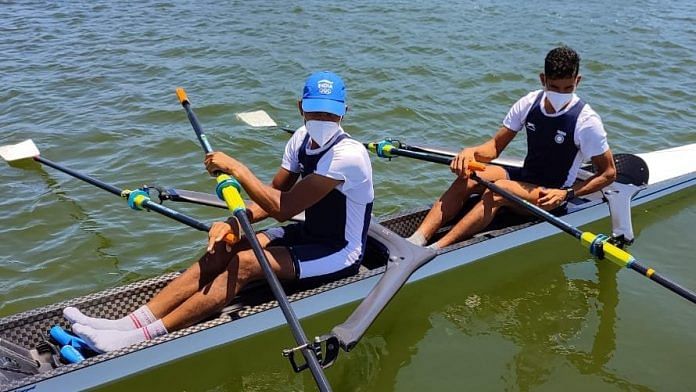New Delhi: At 8 am India time Wednesday, rowers Arjun Lal Jat and Arvind Singh will take part in the semifinal of the men’s lightweight double sculls event at the Tokyo Olympics.
If Lal and Singh finish in the top three at the Sea Forest Waterway in Tokyo, they will earn a chance to compete for a medal in the final round on 29 July.
ThePrint breaks down for you what the lightweight double sculls category means.
‘Double sculls’
At the Tokyo Olympics, rowing is divided into seven categories for men and women — coxless pair, coxless four, coxed eight, single sculls, double sculls, quadruple sculls and lightweight double sculls.
The act of sculling refers to propelling a boat forward with oars on both the port (left) and starboard (right) sides.
As such, a single scull refers to a rowing event in which an individual is operating a boat with two oars, while a double scull denotes a team of two rowers operating the same boat.
Sculling is different from the coxless category, as rowers in the latter only use a single oar each on either side of the boat to row.
In coxless pair and coxless four, there is no coxswain and the rowers use one sweep oar each, to propel the boat forward.
In coxed eight, the eight rowers are also accompanied by a coxswain, who sits at the boat’s stern (back) and is tasked with steering the boat by using a rudder, and dictates the pace at which the rowers operate.
In single sculls and double sculls, too, there is no coxswain, so rowers require a rudder cable attached to their feet in order to steer the boat.
Across the different rowing categories, however, the objective to win remains the same — cross the finish line in the fastest time possible, without obstructing their opponents’ boats or committing more than 1 false start.
Also read: A foot race of only 192.28 meters in length – that’s how the Olympics began in Greece
Lightweight rowing
The lightweight category for rowing was introduced in the 1996 Atlanta Olympics and will be part of the competition until Paris 2024, before it is expected to be replaced by coastal rowing at Los Angeles 2028.
Unlike the other rowing categories at Tokyo 2020, the average weight of lightweight double scull rowing teams is capped at 70 kg and 57 kg for men and women respectively, while individual rowers cannot weigh more than 72.5 kg (men) & 59 kg (women).
The Indians’ repechage journey
After booking their Olympics berth via a runners-up finish at the Qualifying Regatta in Tokyo in May this year, Arjun Lal Jat and Arvind Singh began their campaign with a fifth place finish in their group in the heat round, a distant 16.59 seconds behind the group winner, Ireland.
As a result, the two had to compete in the repechage round for another chance at making the final medal round.
A day after their heat elimination, Arjun and Arvind finished in third place in their repechage group, nearly five seconds ahead of fourth-placed Uzbekistan and nearly eight seconds behind the first-placed Poland, and thus became the last team to qualify for the men’s lightweight double sculls semifinals.
#IND rowers Arjun Lal and Arvind Singh have qualified for the SEMI-FINAL of Men's Lightweight Double Sculls after finishing 3️⃣rd in the repechage round! 🚣🚣#Rowing | #StrongerTogether | #UnitedByEmotion pic.twitter.com/Sn6mX0SWnw
— #Tokyo2020 for India (@Tokyo2020hi) July 25, 2021
Wednesday is expected to be an uphill battle for the Indian rowers as not only will they have to compete with the Irish a second time for a place in the final, but they also recorded a slower time in the repechage than any of the other nations still remaining in the event.
However, Arjun Lal Jat and Arvind Singh’s semifinal berth is currently India’s best ever performance in this Olympic sport.
(Edited by Arun Prashanth)
Also read: Talha Talib had a near-miss at Tokyo. But Pakistanis’ worry is small Olympics contingent



